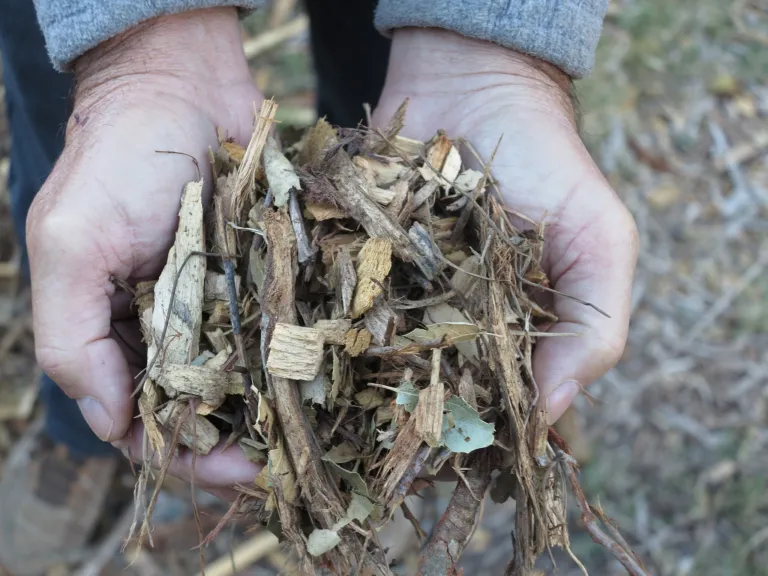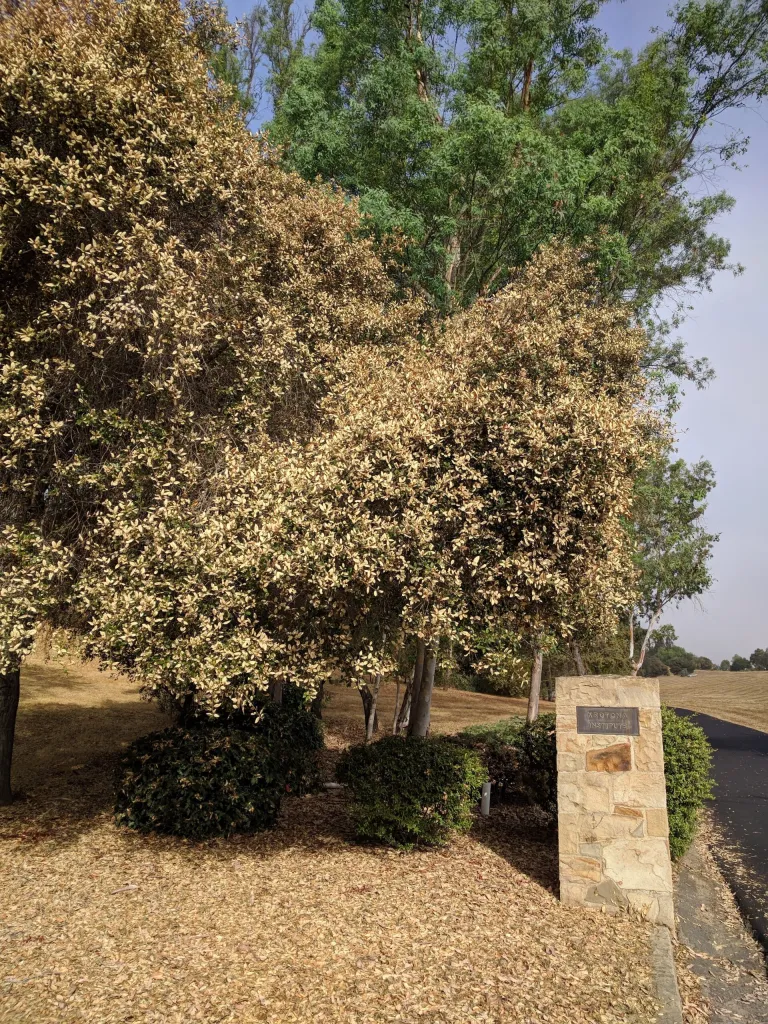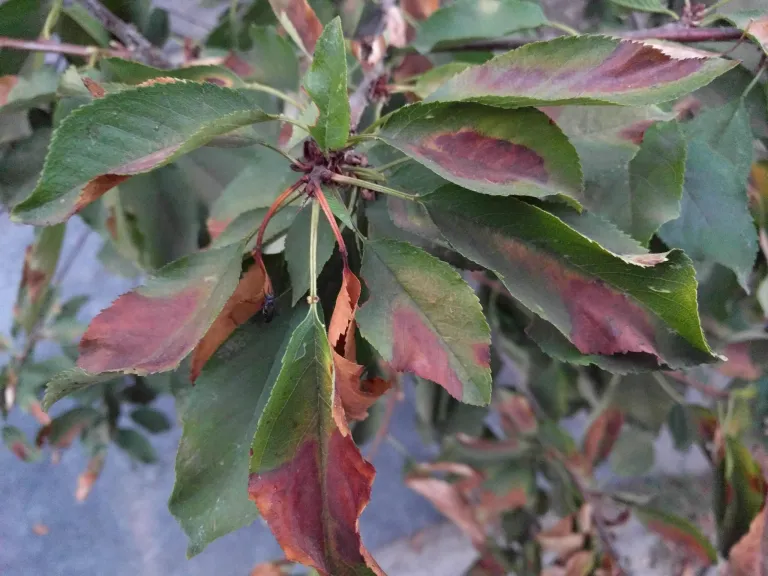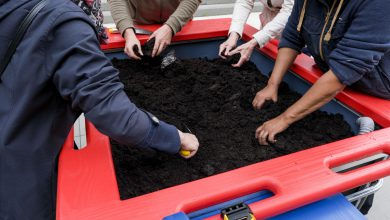
I am a big fan of our ‘garden professors’. These American professors mainly help rid the world of sense and nonsense. You can compare it a bit with our ‘Council of the wise’ who also assist us in word and deed.
They gave these tips and of course the drought hits even more. But it can also inspire us. Because when it drips in America…
Here they come.
Droughts of epic proportions threaten many Western American states this year. For the first time, some water districts have proposed curbing all outdoor irrigation, not allowing water to be used outside homes. Public forums are planned with experts and officials offering advice. A point of great concern is the certain loss of sod, but even more worrisome is the loss of trees.
Drought changes landscapes. This is where European birches have died and that offers opportunities to plant more drought-tolerant species.
Don’t assume your trees will die from drought!
Most established trees are resilient, having strategies in place to avoid and tolerate drought. It helps to understand these processes and to know the symptoms of drought damage in trees. Nearly all trees stop growing when they enter a drought because there isn’t enough water to produce the turgor pressure needed for the cells to grow. Although growth can slow down, trees have root systems that help prevent them from dying from drought. Although the root systems are mostly located in the surface layers of the soil, they also explore greater depths where they can extract water from larger amounts of soil. So even though the soil is dry on top, trees have more access to moisture than can be seen from above. Trees also have mycorrhizal fungi that help them extract water that is tightly bound to the soil. When these strategies become too limited, tree roots produce abscisic acid that flows into the pores in the leaves and closes them to reduce transpiration. If the drought persists, many trees will shed their leaves completely to help the trunk and root tissue survive, thus avoiding drought. All of these mechanisms are driven by the tree’s genetics and their ability to mitigate the effects of drought is variable. Some trees are simply more drought resistant than others.
Some trees, such as this Indian rosewood (Dalbergia sissoo), are adapted to a warm climate and tolerate long dry spells without damage.

Do not plant new trees in the summer!
Now is not the time to plant trees. As we approach June 20 (the longest day of the year), the demand for water is also greatest because sunlight stimulates photosynthesis and thus the water consumption of trees. Newly planted trees all need irrigation to help them get established. During drought years, wait to plant until the later fall months (when the chance of rain is higher and the day length decreases).
Do not fertilize trees during drought!
Fertilizing is the last thing you want to do during or at the onset of drought! Fertilizer (organic or inorganic) contains salts that increase the osmotic potential around the roots. This alone can cause “physiological drought” as water is drawn from the roots into the soil solutions. Fertilizers should only be applied where there are known deficiencies and there is sufficient water to dissolve the applied materials.
Fertilizers increase drought stress for trees when water is not available for application.
Do not prune trees during drought!
Pruning removes terminal buds that control canopy growth. When removed by pruning, side buds are released to grow. Stimulating new growth during drought is a disaster for trees. Do not do it! You may mistakenly think that removing branches from a tree canopy will save water. Most trees can control their own water loss, as discussed above, or by dropping leaves as needed when dry.
Pruning, especially if it’s too thin, encourages new shoot growth — something you don’t want to encourage during droughts.
Do not install artificial grass
Artificial grass is not a solution for hot, dry conditions. In some cases, it can even make the situation worse. Artificial grass does not allow water to pass through and does not collect water because it covers the ground. Artificial grass does not perspire, so landscapes will not be cooled by it. Trees adjacent to artificial grass have fewer opportunities to absorb water than trees adjacent to a mulched area.

Artificial grass does not use water, but it also gets warm. On the day this photo was taken, it was 50 degrees warmer than irrigated grass and 30 degrees warmer than brown dry grass.
The longest day in June may not be the most stressful for trees
When water is scarce, it is important to use it strategically to reduce stress on trees. Although June has the longest day and trees may transpire the most, it may not be the most stressful time for trees as June may still have water available at lower soil levels. As we move in later in the summer and early in the fall, the stress builds as the available water from the trees’ root zones is depleted. Deciduous trees will lose their leaves, but evergreen trees or trees that cannot shed their canopy may reach their permanent wilting stage. This is usually accompanied by wilting, kickback and loss of color. This is a critical point where strategic water applications can help the trees through a critical period.
Use wood chips as mulch
Mulch is an important means of survival for trees in drought conditions. It is best if there is already mulch in place, but it is never too late to apply it. Mulch changes the soil structure, allowing more water to be stored. Over time, mulched soils become more drought-resistant. In the short term, mulch prevents evaporation from soil surfaces, so the applied water stays in the soil and is not lost. Coarse wood chip mulches prevent weeds from consuming water and thus retain more moisture in the soil. Wood chip mulches support the mycorrhizal fungi that help trees survive.

Update existing mulch zones around trees
Mulch breaks down as it should. It is important to keep the mulch layers intact by replenishing them occasionally. If you haven’t already done so, add mulch before summer is too far along.
Remove lawns or shrubs that are no longer viable in the landscape with care.
Due to climate change, the coastal life tree (a native oak) is less adapted to the inland valleys of Southern California than the Eucalyptus camaldulensis (an exotic).
Water restrictions, warm weather and dry soils are a highlight and can severely damage landscapes. If landscapes are overplanted or there are unwanted/unnecessary plantings, they can be removed to conserve the water they would consume. Avoid exposing existing plants and trees to strong sunlight, as sunburn can damage them. Be careful when removing sod and the irrigation that comes with it, as adjacent trees may be dependent on the excess water. Slow drying and mulching can be the best way to save valuable perennials near unsustainable grassland.

Check your trees for signs of impending drought stress and water on time
High temperature damage to cherry leaves is not a symptom of drought but of heat intolerance. As trees dry out, they have less ability to tolerate high temperatures.
Wait until the leaves start to yellow prematurely or the crowns show wilting before watering. If drought symptoms develop, consider watering slowly with a drip hose (move regularly) or a low-flow sprinkler that only waters as quickly as the soil can absorb. Water at night to limit evaporation loss. Keep checking for further drought symptoms and spread the irrigation as needed to conserve water.
Turn off your valve regulators to avoid over-watering.
Don’t let electronic equipment make watering decisions for you during droughts with little water. No electronic system fully understands the stress situation around trees and can accurately predict when to water. It is best to make these decisions based on your own assessment of the circumstances and the resources available. Many “irrigation clocks” rely on regular frequent applications of water to maintain soil moisture levels. Frequent short watering cycles replace the water used by the plants. During drought restrictions, the controllers must be reprogrammed to spray less often for longer (to the point where the water drains) or not to spray at all if the sprinklers are overwatering. Targeted watering will probably be required and valve controls will have to go into “resting position”, ie shut down.

be hopeful
Droughts come and go, right now they just keep coming. But there are many examples of trees that have only received rain, applied no irrigation and still survived well. Don’t assume that your trees will die from drought. This may be a time to remove trees that are not adapted to growing in your area and drought conditions will exacerbate this. European birches are definitely disappearing from many landscapes in Southern California this year. Use more mulch, water strategically, and consider planting more adapted trees in late fall or winter, when water is available to support the planting.
Thanks to our ‘The garden Professors’





